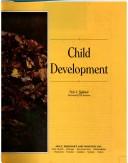| Listing 1 - 10 of 4410 | << page >> |
Sort by
|
Book
ISBN: 0064671496 Year: 1993 Publisher: New York, NY HarperPerennial
Abstract | Keywords | Export | Availability | Bookmark
 Loading...
Loading...Choose an application
- Reference Manager
- EndNote
- RefWorks (Direct export to RefWorks)

ISBN: 0030302935 Year: 1990 Publisher: Fort Worth Toronto Tokyo Holt, Rinehart, and Winston
Abstract | Keywords | Export | Availability | Bookmark
 Loading...
Loading...Choose an application
- Reference Manager
- EndNote
- RefWorks (Direct export to RefWorks)
Book
Year: 1919 Publisher: [Place of publication not identified] : Little, Brown and Co,
Abstract | Keywords | Export | Availability | Bookmark
 Loading...
Loading...Choose an application
- Reference Manager
- EndNote
- RefWorks (Direct export to RefWorks)
This book neither purports to be an exhaustive account of the psychology of the child and of the relation between parents and children, nor does it aim at setting forth only the individual opinions of the author on these two subjects. It is intended to be an examination of them from the point of view which has recently been developed in psychology by that branch of it known as psycho-analysis, and sets forth the conclusions which have been reached by many investigators and which are deemed of importance in illuminating the subject in hand, namely, the mental hygiene of childhood. In presenting this subject of the mental hygiene of childhood I have believed that the best purpose would be served by emphasizing two conclusions, one concerning the child and one concerning the family. The conclusion concerning the child is that, contrary to generally held opinions, it is possessed of a developing sexuality, the roots of which reach back into its infancy. The conclusion concerning the family is also contrary to the opinions regarding that institution commonly held, namely, that there reside within its organization and as a part of its nature certain disruptive tendencies. I have felt that the recognition of these two facts was of the very first importance and have tried to set them forth in a way that would not only help to their understanding, but would also indicate how their recognition, and the incorporation of that recognition as a factor in regulating the life of the child, would be productive of far-reaching results to the advantage of the race. If this book serves its purpose in securing a hearing for these views, the reader may naturally feel a desire to pursue the subject further. I would suggest to such a reader the few works to which reference is made in the footnotes. (PsycINFO Database Record (c) 2016 APA, all rights reserved).
Book
Year: 1938 Publisher: Iowa : The University, Iowa City,
Abstract | Keywords | Export | Availability | Bookmark
 Loading...
Loading...Choose an application
- Reference Manager
- EndNote
- RefWorks (Direct export to RefWorks)
"In this major study of the effects of preschool education on child behavior the four authors have had the courage to see the project through to the end. For this venture, "under controlled conditions," began early to suffer from its initial successes. It will be noted that, on the basis of chronological age, mental age, intelligence quotient, sex, nutritional status and length of residence in the orphanage, one-half of the children of preschool age (1 1/2 to 5 1/2 years) were placed in the new preschool under expert teaching, while an equally matched group was compelled to remain in the crowded, nonstimulating cottage areas. Although even untrained observers could see the differences in behavior which were accumulating, all this was endured for three years. It is believed that the results justify the strict adherence to scientific methods. Certainly no one could have otherwise predicted, much less proved, the steady tendency to deteriorate on the part of children maintained under what had previously been regarded as standard orphanage conditions. With respect to intelligence, vocabulary, general information, social competence, personal adjustment, and motor achievement the whole picture was one of retardation. The effect of from one to three years attendance in a nursery school still far below its own potentialities, was to reverse the tide of regression which, for some, led to feeble-mindedness. Rather, the children were turned toward normality of growth and all-around behavior. Throughout the study there is substantial support for those who regard young children as truly plastic, and very little for those who place great reliance upon the inner forces of heredity as determiners of the rate and extent of development. Since for both the control and experimental groups, the study is close to a minimum of environmental impact (except in a negative sense), what has been done here could be duplicated anywhere. But the next step is not duplication, but to compare extremes. We have in any state institution which is forced to endure understaffing and overcrowding an easy access to poor conditions; that is, to "control" groups. What would happen if a really good model of schooling and adjustment service were applied to experimental groups from infancy to adolescence, carrying on through selected foster homes? For the present, the answer must remain with the reader of this unique report"--Foreword. (PsycINFO Database Record (c) 2010 APA, all rights reserved).

ISBN: 0415058295 9780415058292 Year: 1991 Volume: 1 Publisher: London ; New York : Routledge,
Abstract | Keywords | Export | Availability | Bookmark
 Loading...
Loading...Choose an application
- Reference Manager
- EndNote
- RefWorks (Direct export to RefWorks)
Book
ISBN: 0582324939 Year: 1972 Publisher: London Longman
Abstract | Keywords | Export | Availability | Bookmark
 Loading...
Loading...Choose an application
- Reference Manager
- EndNote
- RefWorks (Direct export to RefWorks)
Book
ISBN: 1538609398 1538609401 Year: 2017 Publisher: Piscataway, NJ : IEEE,
Abstract | Keywords | Export | Availability | Bookmark
 Loading...
Loading...Choose an application
- Reference Manager
- EndNote
- RefWorks (Direct export to RefWorks)
The workshop RED UAS 2017 aims at bringing together representatives from academia, industry, and government agencies working in the rapidly expanding research area of unmanned aerial systems Focused interests of diverse groups involved in UAS research and development will be discussed Special emphasis will be given to current and future research opportunities.
Book
ISBN: 9264914110 Year: 2020 Publisher: Paris : OECD Publishing,
Abstract | Keywords | Export | Availability | Bookmark
 Loading...
Loading...Choose an application
- Reference Manager
- EndNote
- RefWorks (Direct export to RefWorks)
This report outlines six key policy areas which, when taken in a coordinated and coherent way, increase the chances of childhood well-being and address risk factors of vulnerability. These policy areas aim to empower vulnerable families and improve parenting skills, boost children's emotional and social skills, make child protection services more child-centred and accessible and improve after-care services, increase children's educational success and improving early education quality, improve children's health including pre-natal care and nutrition, and reduce children's poverty and material deprivation and removing barriers for parental employment. First, the report looks into the individual, family and environmental factors that contribute to child vulnerability and the special considerations for children in vulnerable countries.
Book
ISBN: 1536109584 9781536109580 9781536109467 Year: 2017 Publisher: New York
Abstract | Keywords | Export | Availability | Bookmark
 Loading...
Loading...Choose an application
- Reference Manager
- EndNote
- RefWorks (Direct export to RefWorks)
Book
ISBN: 0309482054 0309482038 Year: 2019 Publisher: Washington, District of Columbia : The National Academies Press,
Abstract | Keywords | Export | Availability | Bookmark
 Loading...
Loading...Choose an application
- Reference Manager
- EndNote
- RefWorks (Direct export to RefWorks)
"Healthy mental, emotional, and behavioral (MEB) development is a critical foundation for a productive adulthood. Much is known about strategies to support families and communities in strengthening the MEB development of children and youth, by promoting healthy development and also by preventing and mitigating disorder, so that young people reach adulthood ready to thrive and contribute to society. Over the last decade, a growing body of research has significantly strengthened understanding of healthy MEB development and the factors that influence it, as well as how it can be fostered. Yet, the United States has not taken full advantage of this growing knowledge base. Ten years later, the nation still is not effectively mitigating risks for poor MEB health outcomes; these risks remain prevalent, and available data show no significant reductions in their prevalence. Fostering Healthy Mental, Emotional, and Behavioral Development in Children and Youth: A National Agenda examines the gap between current research and achievable national goals for the next ten years. This report identifies the complexities of childhood influences and highlights the need for a tailored approach when implementing new policies and practices. This report provides a framework for a cohesive, multidisciplinary national approach to improving MEB health"--Publisher's description
| Listing 1 - 10 of 4410 | << page >> |
Sort by
|

 Search
Search Feedback
Feedback About UniCat
About UniCat  Help
Help News
News